#reimaginings of popular myths
Explore tagged Tumblr posts
Text
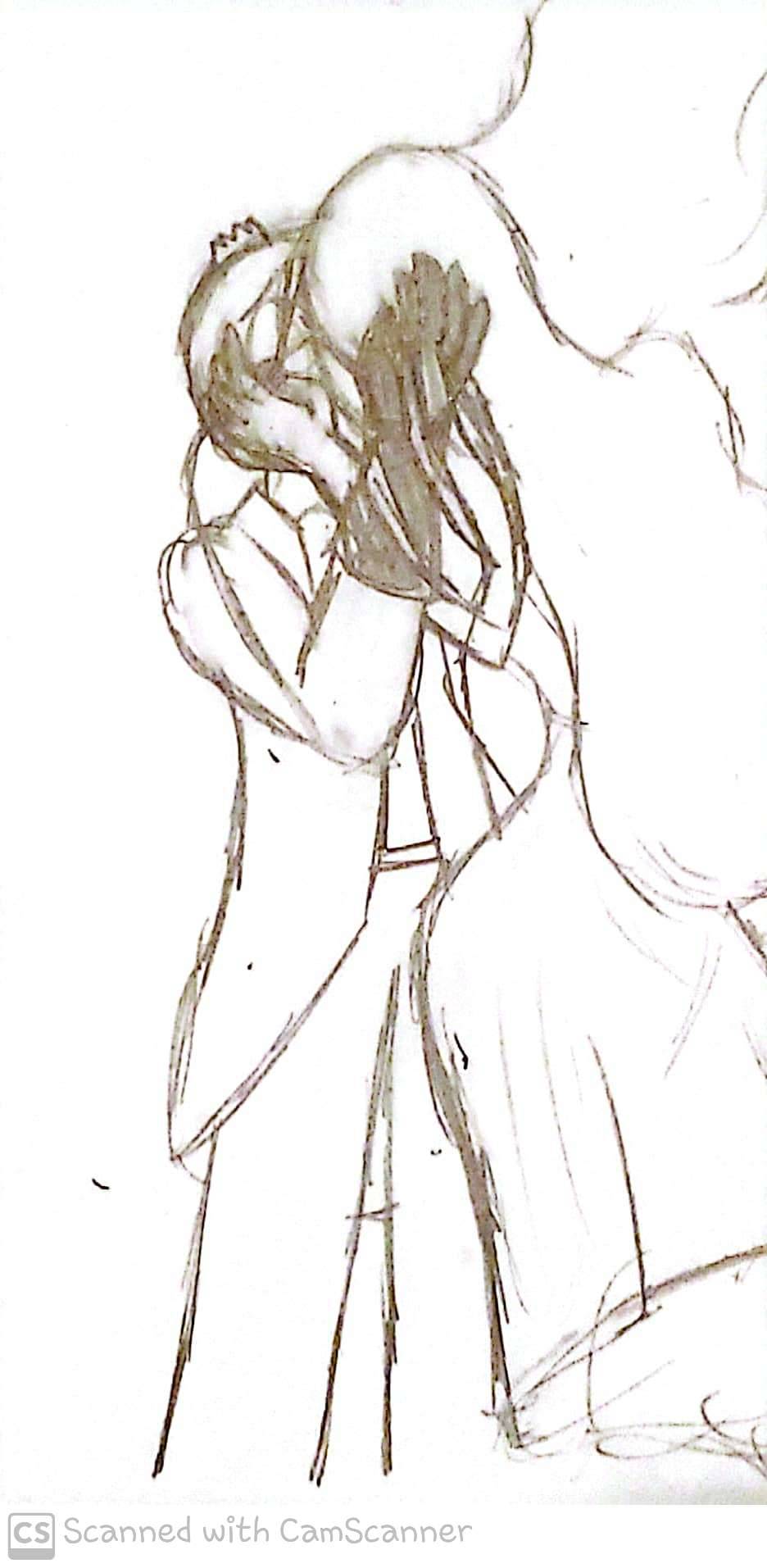
Lay me gently in the cold dark earth,
I'll crawl home to her...
#nemo's art#nemo's arts#original character#ish#reimaginings of popular myths#headless horseman#lady in white#ghostly ever after#living legends#working on the first story for this#🤞hoping to post some#by the end of the year#wish me luck
3 notes
·
View notes
Text
Something that stood out to me a lot from this album is the intentional de-personalization of extremely personal feelings and stories. She seems to have decided for this project that in order to be free to be completely honest in her art (which tbf she always has been but never as much as this album), she needs to visualize herself, and thus her stories, as a third party, an external entity on which she's conducting a post-mortem examination. Her 2016 self and the hate train she suffered after Snakegate is reimagined as Cassandra, a character from Greek mythology who had visions in her dreams but no one believed her and instead she was punished. Her anxiety of holding her lover's career back is instead described as The Albatross, this girl who everyone has been warned to stay away from bc she causes problems and is a liability. Her sweet, innocent childhood self is depicted as a robin, a feisty little bird full of life, dreams, and potential who has yet no clue of the cruelty of the world.
Consequently, the characters in her life are, too, bestowed upon fictional characters from stories that have been told before and/or are familiar in some way to the listener (aIMee the girl from this allegorical high school which is actually Kim Kardashian, Peter the boy who never grew up and stayed forever in Neverland who actually is her long-term ex partner, both her and her lover's separate romantic involvements imagined as Chloe or Sam or Sophia or Marcus, her real life therapist referred to as The Professor etc). By using the representation of well-known characters from widely popular stories and myths with names and all, she creates an even deeper line of emotional connection with the listener. Then, the 4th wall is delightfully broken in Clara Bow, where she refers to Clara Bow and Stevie Nicks as the inherent precedents to Taylor Swift. But what's even more brilliant about this is that in this way, she is making Taylor Swift into a character in and of itself. She is actually attempting to externalize Taylor Swift from Taylor the real-life woman. By narrating her stories through tangible entities presented as completely external to herself, she is inhibited by the safety of this fictional/allegorical lense through which she's allowing her stories to be consumed, and as a result, she has unlimited freedom to be more personal than she has ever been in her art before.
#this gives protection to not only her privacy and her right to a personal life but also the privacy of the real ppl in her life#without her needing to restrain from telling stories that real life ppl are inevitably a part of#it's also just a genuis move as an artist and creator#ttpd#taylor swift#allegory#clara bow#peter pan#robin#The Albatross#thanK you aIMee
758 notes
·
View notes
Text
Ghost Ship | Straw Hats x Reader
★ requested by @supernatural-hunter1 (see here)
Summary: There’s no need to fear Davy Jones and his ship of ghosts. After all, it’s just a myth… or is it? Tags: sfw, platonic straw hats x reader, GN!reader, no use of y/n
Disclaimer: There are many myths and legends about Davy Jones and the Flying Dutchman, but the one here is my reimagined version, borrowing elements from One Piece’s Flying Dutchman lore (Fishman Island Arc, ch. 606) and some from the Pirates of the Caribbean franchise.

It was a festive night onboard the Thousand Sunny.
Earlier, the Captain of the Straw Hat Pirates had begged the cook to prepare a feast tonight, without any reasons whatsoever. The cook was hesitant at first, as he was not one to use excessive ingredients when unnecessary, but with the last of the fresh supplies they got at Water 7 on the brink of losing their quality, Sanji had relented and cooked up an extravagant banquet for the crew.
Not wanting to waste a beautiful moonlit night, the Straw Hats set up picnic blankets on the Sunny’s lawn deck to enjoy their dinner. Franky had busted out his ukulele, playing a cheery tune that transformed the quiet night into a lively one. A portable metal fire pit sat in the center of the lawn, the flames providing light and warmth as the crew partied the night away.
It was not uncommon for this particular crew that a night of drinking would evolve into a night of daring each other to do stupid things. Luffy’s face was currently caked with Nami’s makeup, Zoro and Sanji were reluctantly interlocking hands as per Robin’s dare, and Chopper had one of Franky’s (clean) underwear strung between his antlers. The dares were getting more and more ridiculous as the game went on, to the point where Usopp had just challenged you to skinny-dip off the side of the ship. One glance over the railing at the dark, cold, and uninviting waters had you sitting back down on the deck.
“Yeah, right,” You scoffed and downed a shot in lieu of doing the dare, “That’d get me sent straight to Davy Jones’ locker!”
“Whose what now?” Usopp asked with his head tilted in confusion, the phrase unfamiliar to his ears.
It was such a common saying in the South Blue, where you were from, that you just blurted it out unthinkingly. There were no Southern seafarers who didn’t know about the mythical pirate Davy Jones and his ship full of ghosts.
“The Davy Jones’ locker.” You repeated matter-of-factly. Surprisingly, none of your crewmates seemed to show even a hint of recognition. You eyed them one by one, but all of them sported similar blank looks, “Oh c’mon, Davy Jones? The Flying Dutchman? Ring a bell?”
“Robin, you must know it.” You turned to the archaeologist, certain that she must have read about the legend before in one of her books, but she merely shook her head.
“No way,” you looked at your crew in disbelief, “And you call yourselves pirates?”
“Hey!” Luffy protested indignantly, “What’s a flying locker got to do with being a pirate?”
“Huh,” you shrugged, “Guess the story’s only popular in South Blue then.”
“Ooh, a story?” Chopper leaned forward toward you in anticipation, “I wanna hear it!”
“Alright then, listen up.” You looked at your friends with a sly smile, “But beware, this tale is not for the fainthearted.”
You started the story, lowering your voice in a mediocre attempt to sound spooky, “Hundreds and hundreds of years ago, a pirate crew was sailing on troubled waters when its captain – by the name of Davy Jones – suddenly fell ill and lost his mind. He killed his whole crew, chucking them off the ship one by one into the angry sea.”
Robin’s eyes sparkled with intrigue, while Zoro looked unbothered, but was listening intently nonetheless. Luffy was munching on some meat, only half paying attention. Franky had put down his ukulele, and Sanji took a long drag of his cigarette, eyes never straying away from you. Usopp, Nami, and Chopper had started to huddle together, never ones to enjoy scary stories.
“When he came to, Davy Jones realized what terrible deed he had done and blamed the gods for his madness, throwing curses at the rulers of the seas and the skies.”
The silence that now shrouded the chilly night only added to the tense atmosphere, broken just by the low whistle of the winds against the sails and the faint crash of the waves against the hull. No one dared breathe a word to interrupt as you continued your tale.
“The gods were furious and punished Davy Jones to roam the seas for eternity aboard his ship, the Flying Dutchman, doomed to ferry the souls of those lost to the sea to the world beyond, far deep through the oceanic abyss, which sailors came to know as the Davy Jones’ locker.”
Unbeknownst to the crew, a shroud of unnatural mist has started to surround the ship. Its tendrils snaked through the gaps and crevices, slowly infiltrating the deck.
“They say the Flying Dutchman still roams the seas to this day, never able to make port.” You paused for dramatic effect, “People say, that if you’re unlucky enough to encounter it, you could hear the lost souls onboard the ghost ship sing; Dead men tell no tales, dead men have no desires. Dead men don’t need jewels on their–”
“ENOUGH!!” Usopp yelled, covering his ears, “That’s enough, I don’t want to hear it anymore!”
By this point, the fog had gotten so thick that it was impossible not to notice. The crew was suddenly overcome with a sense of dread, goosebumps creeping on their skin.
“Wh-what is this mist?!” Nami shrieked, “What’s happening?! I don’t like this!”
Zoro and Sanji stood up, whipping their heads around in search of enemies or threats, but nothing emerged from within the murk. Nami and Usopp were now clinging to each other, screaming their heads off when suddenly, Chopper pointed at something in the distance and squealed, “Wh-wh-what’s that?!”
A silhouette of an old, rickety vessel materialized from beyond the mist, sailing head-on toward the Thousand Sunny. Its tattered sails swayed in the winds, a faded glow cloaking its body.
Screams of panic filled the air as Usopp, Nami, and Chopper ran around in terror.
“That’s it, I’m going inside! You guys deal with that!” Nami exclaimed, rushing towards the safety of the sleeping quarters.
“Oi, Nami, wait for me!” Usopp ran after her, Chopper closely following behind, “Can I sleep in the girls’ room tonight?!”
“Nah, man.” Zoro shook his head, “Give me monsters or devils, and I’ll fight them. But, I don’t fuck with things I can’t cut with my swords.” He said before hightailing it to the boys’ quarters.
Sanji stammered that he was “definitely not scared of ghosts, unlike the cowardly mosshead” but claimed that he wanted to make some midnight snacks and speed-walked to the kitchen. The mere mention of a midnight snack had Luffy following Sanji like a puppy, all thoughts of ghosts or whatever vanishing from his mind, and so he too, was gone.
With most of the Straw Hats cowering inside, the deck was once again plunged into a thick silence as the mysterious ship crept closer and closer.
A sudden slow clap permeated the stillness.
You looked behind you to see Robin smiling knowingly, “Incredible.” She chuckled, addressing you and the only other remaining Straw Hat on deck, “How did you two do it?”
“I don’t know what you’re talking about, Robin.” You deflected unconvincingly, trying to hold back a smile.
“Yeah, Robin, what do you mean?” Franky added with a cheeky grin, “That’s totally a real ghost ship comin’ right at us.”
“Alright, keep your secrets.” Robin said with a laugh, “I’m going to bed. Make sure you clean up nicely, hm?”
Once Robin was out of sight, Franky offered his big metal hand to you, and you slapped it in an enthusiastic high-five. The two of you broke out in laughter, ecstatic at the success – for the most part – of your harmless but elaborate prank.
“Ah, that was a good one.” He sighed, wiping a stray tear from his eye, “Did you see their faces?”
You grinned at him, “I thought we fooled everyone, but Robin’s a tough one, isn’t she?”
“She’s super smart,” Franky laughed, “I knew from the beginning that she wouldn’t buy it.”
He took out a remote from his shirt pocket and pushed the big red button on it. Instantly, the mirage of the ghost ship disappeared as the light projector hidden inside the lion figurehead’s mouth was deactivated. The smoke machines mounted through the side portholes also died down, and the thick fog surrounding the ship gradually dissipated.
Since no one was around anymore, you and Franky took up the job of cleaning up the lawn, considering it as a way to make up for the fright you gave the rest of the crew. You stacked the dirty plates, gathered all the empty booze bottles, and folded up the blankets. The big, yellow moon provided ample brightness even as Franky killed the fire.
“Franky,” You called out as you noticed something in the horizon, “I thought you shut off the machine.”
“Yeah, I did.” The cyborg replied without even looking at you, still focused on cleaning the fire pit.
A chill of uneasiness ran through you at his answer, “Then… what’s that?”
Franky looked up at your shaky voice and turned to the front of the ship, eyes bulging in shock at what met his sight.
A curtain of thick, black fog coated the ocean and sky ahead, swallowing the stars from the sky and plunging the waters into total darkness, where no moonlight reached it.
And the Sunny was sailing right at it.
You and Franky could only stare at the unfathomable phenomenon as you stood frozen side-by-side.
“Oh, we are super fucked, aren’t we?”

a/n: bonus points if you got what the thick fog at the end was supposed to be! anyway, i had so much fun writing this!! it might be a bit early for a halloween post but i hope you all enjoyed this silly little fic nonetheless 🧡
↳ masterlist
#one piece#one piece fluff#one piece x reader#one piece x you#one piece x y/n#one piece imagine#straw hat pirates#straw hat pirates x reader#straw hat crew#one piece fanfic#op fanfic#monkey d luffy#luffy#sanji#black leg sanji#roronoa zoro#zoro#cat burglar nami#nami#usopp#nico robin#one piece franky#cyborg franky#tony tony chopper#chibinasuu fics#chibinasuu reqs
200 notes
·
View notes
Text

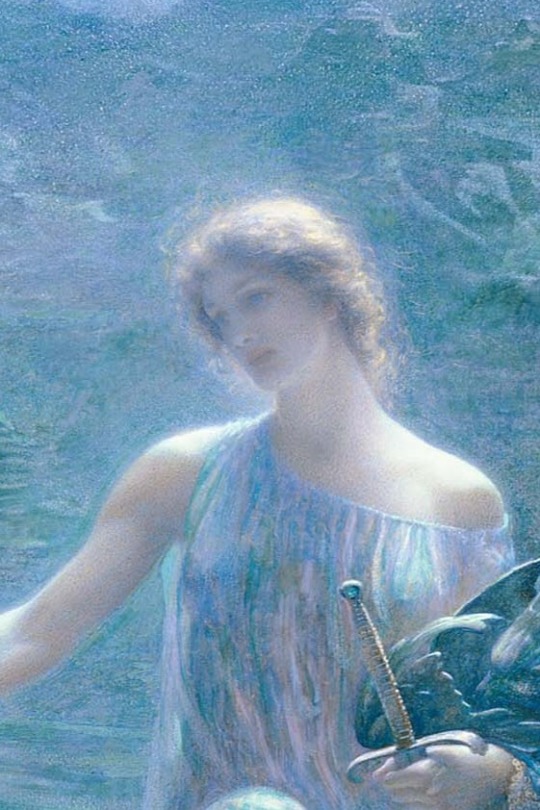



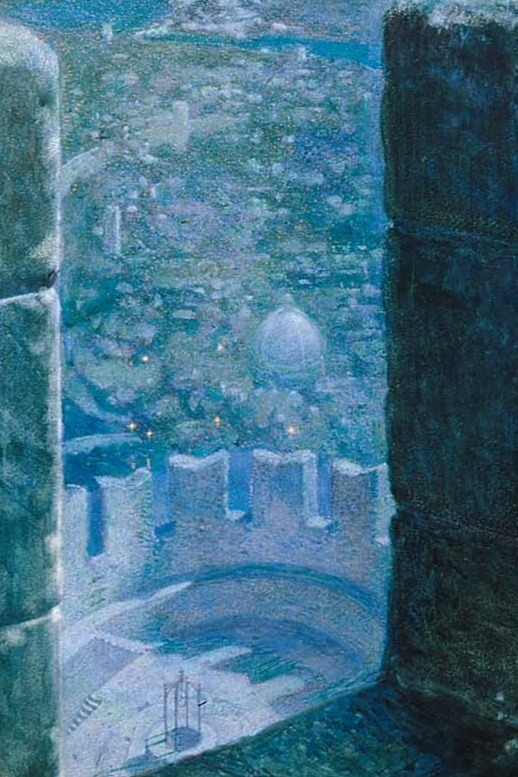
EDWARD ROBERT HUGHES ‐ THE VALKYRIE’S ’s VIGIL, c. 1906
The depicted woman is a Valkyrie, one of Odin’s warrior goddesses in Old Norse mythology. She is responsible for guiding the bravest warriors who perish in battle to Valhalla, the afterlife hall of Odin where the most courageous warriors reside forever.
The Valkyrie is shown perched on top of the castle battlement. She waits with her helmet and sword, ready to bring the latest warriors to Valhalla. A soft, bright white light flows down onto her from the top. Hughes portrays a serene and peaceful moment amidst the assumed violent battle she is overseeing.
The story regained popularity after Richard Wagner's famous 1870 opera, Die Walküre (The Valkyrie), which includes the well-known song, "Ride of the Valkyries". During this time, it was typical for old myths to be reimagined in romantic ways. Hughes created another artwork in 1902, which portrayed a Valkyrie, titled "Dream Idyll (A Valkyrie)."
This potrayal is very different from that of a Valkyrie, who could be imagined to be a ruthless character associated with death and battle. The absence of a wolf or raven, symbols of war, goes on to underline this softer interpretation further, letting viewers delve deep into the depths of her character beyond a warrior.
99 notes
·
View notes
Text
I've seen a few different threads around over the last few days debating whether people are 'allowed'/whether they should keep reimagining the myth of Persephone's abduction, and it feels to me like these discussions are actually two different conversations that have been flattened into one. I am staunchly in favour of retellings and reimaginings. I may not always agree with what an adaptation etc. does, but ultimately I'm always enthusiastic about people engaging creatively with myths, legends and folklore. Not everyone feels this way, and a lot of people are fiercely protective over what they consider the "correct" version of a myth. Hence the common resurgence of debates like the one about reimagining the Persephone myth.
Thing is, you can be both enthusiastic and critical about retellings – indeed, sometimes you need to be critical of them. The Rape of Persephone is a really good example of this, actually. The version most children learn goes like this: Persephone is abducted because Hades has fallen in love with her; Demeter holds the fate of the human race hostage against Zeus until he agrees to send Hermes down to save Persephone from Hades; Persephone eats six pomegranate seeds, so she has to remain in the underworld for six months of the year. What's crucial here is that this popular, sanitised version reframes Persephone's plight as her fault. She is so beautiful that Hades can't resist her. She eats the seeds willingly. It's an ancient myth given a new facet, but it's a facet cut by modern misogyny* – and that's definitely something to criticise. In the Homeric hymn to Demeter, the oldest extant written record of the tale, Hades feeds Persephone the seed by force and deliberately conceals this act from Zeus. He knows it's wrong, and the audience knew it was wrong, and there isn't a reason why making the myth child-friendly had to involve cutting this part out.
Does that mean nobody should ever retell the myth? No! But we should definitely ask why this version has become so popular, and consider what it says about our contemporary society.
*Ancient Greek society was highly misogynistic too, make no mistake. Yet (male!) classical writers didn't pull their punches when it came to showing Persephone's distress and the horror of her situation.
101 notes
·
View notes
Text
okay I was asked about fey books I’ve read that Do stick to folklore a bit more than certain popular books - and actually looking at what fey books I’ve read it’s a bit like.... books that stick to folklore closely I sometimes Don’t Love, and there are others that don’t stick to it as much but I like the overall narrative more? or some mix of that.
so here’s a list of a few - a range of how much they stick to folklore (which of course is an amorphous thing) and how much I like them, but it’s something!
YA
That Self-Same Metal - literally just read this, it’s about a Black girl who’s the stage blade expert for shakespeare’s company and can see fey, and they’re appearing more and more in the city. explores a bit of the midsummer night’s dream fey but also like “shakespeare was wrong” and general folklore. definitely the start of a series and has a lot going on but I thought it has some cool ideas!
all Holly Black’s books deal with them well! the Modern Faerie Tales companion/trilogy has maybe aged a bit by now, and I hate way the romance ended up together in The Folk of the Air (and the way the fandom is about it) but otherwise I do really like how it deals with fey and politics! also enjoyed The Darkest Part of the Forest. these are all intertwined/same world
The Buried And The Bound - a hedgewitch girl keeps fey away from her town, and gets caught up with two boys who are cursed. mostly deals with minor fey and a powerful hag
An Enchantment of Ravens - it’s been quite a few years since I read this, but I do remember enjoying it. It is a bit more of a romance focused story also, an artist stolen into the fey realm for painting a fey prince as if he was human(iirc?)
The Bone Houses - not directly dealing with fey, but like the aftermath of the ancient fey’s curses? welsh myth inspired. which I think is cool.
At The Edge of The Woods - about a girl in a religious/patriarchial village who starts to have strange dreams about a fey boy luring her into the woods. it’s not super focused on them, but they’re very much the classic ‘dangerous fey stealing people away for entertainment’ kind of thing
Adult
Emily Wilde’s Encyclopaedia of Faeries - I sort of have mixed feelings about this - I really enjoy how it dealt with fey and the creepier folklore creatures side of it! the handling of the changeling was a bit iffy and not sure about the romance
The Wolf Among the Wild Hunt - dark fantasy novella about a wolf-shifter made to join the wild hunt to save his qpr. focused on the unseelie/wild hunt area
Silver in the Wood - gaslamp fantasy novella about the keeper of a magical forest, dryads and dangerous fey
The Wind City - a bit of a mashup of fey folklore and Māori atua in a modern NZ setting
Sinners/Veiled - very classic but also with the element of a modern setting where human pollution is like a drug to fey (and the MC is a drug lord.) (so kind of dark but also not dark in the sexy way bc the MC is aroace)
Under The Pendulum Sun - this is a gothic fantasy that has a bit of a new take on a fey world, but also definitely has some of those creepy folklore vibes.
Siren Queen - this only partly involves fey but I thought the way that it mashed up old hollywood and fey (aka shady deals for fame themes) was interesting!
Sorcerer to the Crown/The True Queen - my memory on this is hazy, but I believe it’s regency fantasy, with its own take on a fey world/magic (moreso the 2nd book)
Malice/Misrule - adult high fantasy lesbian sleeping beauty reimagining, this is kind of doing it’s own thing I guess (I don’t remember if they’re even called fey?) but definitely has a bit of the creepy creature/court vibes in book 2 especially
In The Jaded Grove - I was just looking up books to see if there was anything I missed and found this, which seems interesting to me!
I also haven’t read Jonathan Strange and Mr. Norrell (but I watched the show ages ago) and I believe that has the vibe too
#book list#im sure there are some im missing HAHA#some I left out like the witch king (kinda doing its own thing and then calling them fey) or ash/huntress (only lightly touches on fey tbh)#laya talks#the iron fey i loved some of the ideas but the story is kinda bad#wicked lovely.........i can't tell what is nostalgia and what is objective but I did love that series a Lot#(it's quite 2000s YA romance focused but like also. good fey)
214 notes
·
View notes
Text
There is a popular quote attributed to both Fredric Jameson and Slavoj Žižek arguing that it is “easier to imagine the end of the world than the end of capitalism.” It is an odd thought to process while watching Rhys Frake-Waterfield’s Winnie the Pooh: Blood and Honey, a schlocky horror film that reimagines A. A. Milne’s loveable anthropomorphic teddy bear as a hack-and-slash movie monster. Still, it’s something that bubbles through the film’s very existence. Blood and Honey can be understood in a couple of different contexts. Most obviously, it is a transgressive horror film that uses the iconography of beloved childhood figures in a grotesque and unsettling way as a shortcut to cheap thrills. There has been a recent spate of these movies, including The Banana Splits Movie and The Mean One. Later this year, Five Nights at Freddy’s will adapt the beloved video game, riffing on the same basic idea of cute childish things turned violent. However, Blood and Honey stands apart from these contemporaries. It isn’t a pastiche like Five Nights at Freddy’s, it isn’t a licensed production like The Banana Splits Movie, and it’s not an unauthorized parody like The Mean One. It is an adaptation of A. A. Milne’s beloved children’s classic, made possible by the fact that Winnie the Pooh has entered the public domain. Nobody has to pay to use the character, and no authority has the power to veto what can be done with him. Copyright law is an interesting thing. The Copyright Act of 1790 enshrined legal protection of an author’s right to their work for “the term of fourteen years from the recording the title thereof in the clerk’s office.” However, that period of protection would be expanded over the ensuing centuries. With the Copyright Term Extension Act, arriving in 1998, that protection was extended to the life of the author plus another seven decades. Of course, the reality is that copyright doesn’t always protect the artists. It often exists to enrich corporate entities. Much of the most lucrative intellectual property on the planet is controlled by faceless companies that ruthlessly exploit the artistry of their employees and contractors. Comic book movies are a billion-dollar industry, but key creative figures have to fundraise to pay medical bills, like Bill Mantlo. Creators like Jack Kirby or Bill Finger never got to enjoy the spoils of their labor.
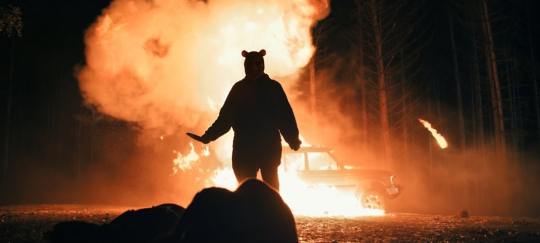
Indeed, these extensions to the period of copyright were largely driven by companies holding these intellectual property rights. The Copyright Term Extension Act was known in some circles as the “Mickey Mouse Protection Act,” reflecting Disney’s proactive lobbying in favor of the extension. Incidentally, Disney paid $350 million to buy Winnie the Pooh from the A. A. Milne estate in March 2001. It is ruthless capitalism, rooted in these companies’ desires to control the public imagination. The Copyright Term Extension Act ensured that no media entered the public domain between 1998 and 2019. As much as writers like Grant Morrison might argue that superheroes are the modern equivalent to the classic Greek gods, this ignores the fact that mythology is a public resource. The classic myths were not owned by large corporations that could use the threat of legal action to pull Vera Drew’s The People’s Joker from the Toronto International Film Festival after a single screening. This makes Blood and Honey a pointed act of transgression. The film comes from writer and director Rhys Frake-Waterfield, best known as a producer of low-rent schlock like Dinosaur Hotel and Dragon Fury. Realizing that A. A. Milne’s beloved childhood fable was entering the public domain, Frake-Waterfield sensed an opportunity. With a budget of under $100,000, he set out to make a quick cash-in slasher movie. Of course, Frake-Waterfield could only draw from elements included in the earliest stories. He had to avoid the iconic material added to the mythos in the years that followed. “Only the 1926 version is in the public domain, so those were the only elements I could incorporate,” Frake-Waterfield admitted. “Other parts like Poohsticks, and Tigger, and Pooh’s red shirt — those aren’t elements I can use at the moment because they’re the copyright of Disney and that would get me in a lot of trouble.” Blood and Honey is a bad movie. It is lazy, uninspired, and boring. It has no sense of character, theme, or basic structure. It’s a lazily reskinned version of Halloween or The Texas Chainsaw Massacre from a filmmaker who spent a significant portion of the press tour passive-aggressively complaining about how Halloween Ends took “itself too seriously.” There is nothing of any merit here, nothing to hold the audience’s interest. The film’s 84-minute runtime lasts several lifetimes. That said, there is a germ of an interesting idea in the central concept, which has an adult Christopher Robin (Nikolai Leon) returning to the childhood fantasy that he abandoned to go to college. He discovers that his childhood did not take well to this abandonment. Winnie the Pooh (Craig David Dowsett), now a feral and mute beast, chains Christopher up and tortures him. He whips the adult with Eeyore’s tail. However, Winnie the Pooh cannot kill Christopher. He must possess him.
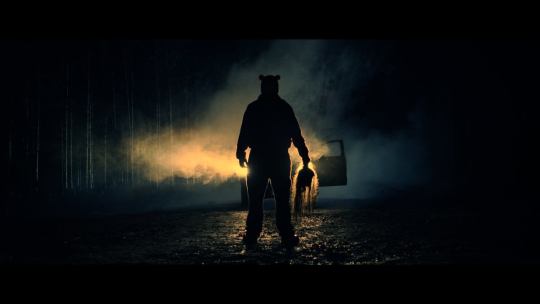
It is too much to suggest that this plot is mirrored in the story of the film’s actual protagonist and decoy final girl, Maria (Maria Taylor). Maria is taking a trip into the country with her girlfriends, recovering from a traumatic experience with a male stalker (Chris Cordell). When Maria’s friend Lara (Natasha Tosini) spots Pooh lurking around the Airbnb, she assumes that he must be Maria’s stalker. Pooh’s psychopathic sidekick, Piglet, is also played by Cordell, to underscore this connection. At times, Blood and Honey seems like it might be a clever and subversive commentary on the way in which so much modern pop culture infantilizes its audience. Christopher has tried to grow up and leave his childhood behind, even planning to marry his fiancée Mary (Paula Coiz), but his childhood won’t leave him behind. Pooh needs Christopher, his validation and his love. However, that relationship is not as innocent as it appears framed through childhood memory. Many modern adults would empathize with this idea, as their childhood nostalgia is weaponized against them by streaming services and studios. Even if one lives in a remote cabin in the woods, franchises like Star Wars, Teenage Mutant Ninja Turtles, He-Man, and X-Men: The Animated Series are inescapable. Entertainment that was once aimed at children is now aimed at the adults those children became. There is no indication that these corporations are ever going to stop. Of course, this gives Blood and Honey too much credit, suggesting that it can be read as a subversive commentary on the role that this sort of intellectual property plays in cultural stagnation. In reality, Blood and Honey is an illustration of just how pervasive this model of capitalism can be. Frake-Waterfield isn’t using Pooh to make a point about the cynical exploitation of these cultural touchstones. He is using it as a cynical exploitation of these cultural touchstones. Blood and Honey grossed nearly $5 million at the global box office, and one suspects that it performed very well on home media and streaming. There is already a sequel in the works with “five times the budget.” More than that, Frake-Waterfield has made a conscious effort to expand the brand into a shared universe built around similar properties. He will direct Peter Pan’s Neverland Nightmare and will produce Bambi: The Reckoning, which was sold to international distributors at Cannes this year. Frake-Waterfield doesn’t just have his eye on these sequels and spin-offs. He dreams of a bigger childhood horror shared universe. “The idea is that we’re going to try and imagine they’re all in the same world, so we can have crossovers,” he boasted. “People have been messaging saying they really want to see Bambi versus Pooh.” It’s incredibly ruthless and cynical. It is a transparent attempt to build a massive multimedia franchise from elements that the production team don’t have to pay for.

In theory, the liberation of these iconic characters from copyright should herald encourage creativity and ingenuity. It should allow for more projects like The People’s Joker or Apocalypse Pooh. There are certainly artists engaged in that sort of work. It also provides the opportunity for commentary and engagement with the modern media landscape. Last Week Tonight with John Oliver is already salivating at the satirical potential of Mickey Mouse’s entry into the public domain. Blood and Honey suggests an alternative to these creative uses of works leaving corporate purview. Blood and Honey is just as cynical and ruthless in its exploitation of this intellectual property as Disney had been. Frake-Waterfield is clearly aspiring to exploit these properties in exactly the same way that Disney did, hoping to create a scale model of their production machine. It is a trickle-down shared universe, a reheat of a familiar meal constructed from pre-digested ingredients. For all the moral handwringing about how the movie “ruined people’s childhoods,” this is the real horror of Blood and Honey. It suggests the limits of creative imagination, an inability to conceive of an alternative to the model of intellectual property management that defines so much contemporary pop culture. The roots of this mode of thinking run so deep that it seems impossible to imagine any alternative. The public domain doesn’t free this intellectual property from endless exploitation, it just means somebody else gets to take a turn. If the rights to Winnie the Pooh are entering the public domain, why wouldn’t somebody use the brand recognition to make a quick and easy buck? After all, the business logic behind Blood and Honey is the same logic behind something like The Little Mermaid or Ant-Man and the Wasp: Quantumania. People recognize the brand, and that will make it easier to sell. Even this seemingly subversive and rebellious act is just a cheaper, more cynical, and less competent iteration of the larger processes that drive modern media. All things considered, the cynicism of Blood and Honey is a small price to pay for the possibility of more work like The People’s Joker. More than that, if it helps to undermine or shatter the brand loyalty that these corporations have cultivated among generations of movie-goers, it may serve some purpose. Still, it’s disheartening to watch Blood and Honey, realizing that these modes of exploitation are so deeply ingrained in pop culture that they perpetuate even in the public domain. Even as the end of copyright becomes a reality, the end of this intellectual property churn remains beyond imagination. Oh bother.
106 notes
·
View notes
Text
Top 15 Werewolves

If there is a specific trifecta of truly classic monsters - a Terrible Trio as iconic together as they are separate - it would undoubtedly be Count Dracula, Frankenstein’s Monster, and the Werewolf. The interesting thing there is that, while “Dracula” and “Frankenstein” are specific creations, the werewolf is more woolgathering. (Ha-Ha! Sheep puns for the win!) There is no Bram Stoker or Mary Shelley novel for the werewolf that everyone looks to for inspiration and remakes, reimagines, or re-adapts over and over again. Yet, at the same time, the idea of the werewolf is older than either Dracula or Frankenstein and his progeny: werewolf myths can be traced back all the way to Ancient Greece. That’s older than even most vampire legends! And that, dear readers, is probably why this list proved…challenging. I could go on and on about the symbolism of the werewolf, the themes present in most werewolf tales, the appeal and evolution of the concept, and so on…but I’m not going to right here in this introduction, for two reasons. First of all, because I will have ample room to bring those things up throughout the countdown…and second of all, because I just want to state OH MY FREAKING GOD, YOU HAVE NO IDEA HOW HARD IT WAS TRYING TO MAKE THIS LIST. This was sincerely one of the most frustratingly tricky lists for me to sort out that I’ve ever made. There are multiple reasons why, but it ultimately comes down to two major ones: first, much like with vampires, I haven’t seen every single werewolf-related thing under the Sun. So I knew there were a lot of really popular werewolves that I couldn’t rightfully include simply because I don’t know anything about them. Second, for the ones I DID know, it was hard to figure out what would make certain characters count, and what would help determine who ranked higher than others. There were just a lot of different factors to consider. Just as there were two major issues that made this difficult, I ultimately made my choices based on two points. First, I decided to exclude characters who were anthropomorphic wolves, but weren’t necessarily werewolves: to qualify, the characters in question had to either shapeshift from a more human form to a more wolf-like form, or - if they were in the same form all the time - the human side had to be more the focus. Second, I simply asked myself one question: “What characters do I think of most when I think of werewolves?” That was really the plain and simple point, and I tried to approach my rankings based on that: this is not a list of the “hottest” or the “coolest” werewolves, and it is not a list of the most sympathetic or the scariest werewolves, nor is it - for a change - a list about which ones I’d rather play or write for the most. I’m still not sure the ranking here is in any way definitive. If there are wolf characters you don’t see here that you really love (I KNOW there WILL be, frankly), the chances are high that I either just don’t know them, or they just didn’t make the cut because, again, this was a very difficult list to sort out in general. If you don’t like it, make your own. :P With that said…in honor of Halloween, here are My Top 15 Favorite Werewolves!

15. Grimm, Caesar, and Douglas Wolf.
From the games “A Villain’s Twisted Heart,” “Ozmafia,” and “Lost Alice,” respectively. I decided to include all three of these characters in the same spot because a.) I like all three of them roughly the same, and b.) all three of them have a lot in common. Grimm, Caesar, and Douglas are all “anime boi” type characters, all of them originate from fairy-tale themed romance games from Japan, and all three of them are their universe’s version of the Big Bad Wolf from “Little Red Riding Hood.” All three also start off the stories they appear in as villainous characters: brutal, vicious, murderous monsters, who will gobble you up as soon as look at you. However, in all three cases, as their stories in the games go on, you do see more sympathetic sides to them; in the cases of Grimm and Caesar, you even have the option and ability to fall in love with them. Douglas remains a villain to the end, but that’s about the only EXTREMELY major difference within the trio, at least that’s worth noting for this countdown. While I love all three characters, and the obvious eye candy cannot be ignored, I frankly don’t tend to think of “sexy anime guys” first when I think of the word “werewolf,” so I decided to place them very low on the list. Sorry, for any (if any) who were hoping they’d be higher.

14. Keaton, from Fire Emblem.
Yet another “anime boi” character. (Don’t worry, if you’re not a fan; they won’t be in great abundance from this point on.) I’m not SUPER familiar with the Fire Emblem universe as a whole, but I AM fairly well-versed with at least one character, and that is Keaton. He is the leader of a pack of lycanthropes referred to as “Wolfskins”: a tribe of barbaric, man-eating hunters living in the mountains of Nohr. They are able to shapeshift from an appearance that looks basically human, but with some wolf-like traits, to huge, hulking, grotesque monsters that are even more wolfish in form. At first, Keaton is an enemy of the main characters, but he ultimately becomes an ally and a friend and joins forces with the heroes on their journey. Keaton is one of those characters I love who effectively has two different sides to his personality: on the one hand, he’s a bloodthirsty sadist who makes no secret of the fact he enjoys tormenting his prey, and even collects the bones of some of his victims. On the other hand, however, once he comes to trust you and care about you - which is absolutely possible - he suddenly becomes flat out adorable: just a scruffy, silly puppy dog who likes to act all big and scary, but really is a softy. The funny part about this is that neither side is a facade for the other: Keaton is both a savage beast and a sweetheart, and that dichotomy is just so interesting to see at work.

13. Eddie Munster, from The Munsters.
From Japanese gaming guys, to suburban USA; what a segue. “The Munsters” was a 1960s sitcom series, inspired by the popularity of “The Addams Family,” which was going on around the same time. Though it only lasted two seasons, the show made a big impact, largely due to its interesting premise: it featured a family of Universal Monsters, interacting with the normal folks of the American town around them. While the original Wolfman - here called “Uncle Lester” - did appear in a couple of episodes, the most prominent werewolf character of the series was Eddie Munster: the daughter of Herman Munster (Frankenstein’s Monster) and his lovely bride, Lily (Dracula’s Daughter). How they gave birth to Eddie is beyond me, but regardless, Eddie is probably the friendliest and most adorable werewolf you could ever meet. The character didn’t start off that way, though: in earlier ideas for the show, including an unaired pilot, Eddie was a vicious, bratty little gremlin. However, by the time the show officially aired, the character had changed into a loving, happy young fellow who simply enjoyed spending time with his dad and was never seen without his beloved werewolf plushy, Woof-Woof. The character was originally played by Butch Patrick on the TV show; like other Munsters characters, Eddie has been reimagined and reinterpreted a few times over the years, but not a single version has really had the success that the original had.

12. Jiro, from Kamen Rider Kiva.
And now we return to Japan, though this time in the world of live-action media. I’ve mentioned “Kamen Rider Kiva” a couple times this month, and on other past occasions, but for those who don’t already know: the long and the short of “Kamen Rider Kiva” is a Japanese superhero show themed around Universal Monsters. One of the main characters of the series is our resident anti-hero, Jiro - a.k.a. Garuru - the last of the Wolfen Race. Most of his most prominent appearances take place in the past scenes of the series, set in 1986. For much of that section of the series, Jiro is an antagonistic presence; unlike Universal’s Wolfman, he isn’t a tortured soul tormented by his animal nature, but instead a cynic who sees the world of humans as corrupt and filled with folly. He enjoys devouring people whole, especially young women, and is as seductive as he is dangerous. However, as the series goes on, he shows more and more of a noble side to his character. By the time of the present day in the show, Jiro has changed his ways, and now works alongside Riki (the Frankenstein Monster character) and Ramon (the Creature From the Black Lagoon) to assist the main protagonist, Wataru, on his quest to defeat the vampiric Fangires. In his human form, Jiro was played by Kenji Matsuda. As Garuru, he was played by Seiji Takaiwa.

11. Man-Wolf AND Werewolf By Night, from Marvel.
Just as Marvel has had many wizards and vampires, it is also home to multiple werewolves. And just as I credited two vampires from the comic company in the past, I’m going to credit two werewolves. First, there’s Man-Wolf; a recurring foe of Spider-Man. The Man-Wolf is actually John Jameson, the son of J. Jonah Jameson. John is an astronaut, who was transformed into the monstrous Man-Wolf thanks to a mysterious ruby he found while exploring the Moon. (As you do.) The jewel was grafted to his skin, and though it was eventually removed safely, John has returned to his Man-Wolf form off-and-on throughout comics history. Next, there’s the Werewolf By Night. A couple of people have held this title, the first and most famous being Jack Russell: a man whose entire bloodline is plagued by the curse of the werewolf. Initially a drifting beast of ambiguous alignment, the Werewolf By Night now uses his lycanthropic abilities to battle other supernatural terrors and criminal powers. While neither character is a household name, both have shown up in other media multiple times; Werewolf By Night, for instance, recently got a very interesting short film adaptation in the MCU, where Jack Russell was played by Gael Garcia Bernal. As for Man-Wolf, while John has appeared multiple times, his werewolf alter-ego isn’t QUITE as common. His most popular appearances have been in cartoon shows like “Spider-Man Unlimited” and “Ultimate Spider-Man.”

10. Ethan Chandler, from Penny Dreadful.
“Penny Dreadful” was a Showtime series that was made in homage to the various characters and tropes of “Ye Olde Gothic Horror.” The main cast consisted of a combination of original characters, as well as figures from famous works of dark classic literature, such as “Dracula” and “Frankenstein.” Ethan Chandler - played by Josh Hartnett - was sort of in-between. At the start of the series, Ethan is a gunslinger working as a performer for a Wild Bill style traveling show. He leaves show business - albeit reluctantly - after being offered a job as a bodyguard by the two main protagonists of the series, Vanessa Ives and Sir Malcolm Murray. Ethan thus joins them on their quest to find the vampire that kidnapped Sir Malcolm’s daughter and Vanessa’s friend, Mina, and thus the series is set in motion. However, things take a turn when it’s revealed Ethan has some dark secrets of his own: his real name is Ethan Talbot, and he is - what else? - a werewolf. (Interestingly, while Ethan’s true name was inspired by the Wolfman, Josh Hartnett’s werewolf makeup was inspired by an earlier Universal werewolf, the Werewolf of London.) As a man, Ethan is a charming, heroic, attractive fellow, albeit not one without flaws. When he becomes a werewolf, however, he turns into a feral, monstrous beast that has no other purpose but to kill. As a werewolf, Ethan recognizes neither friend nor foe, simply lashing out in bestial fury at anything and anyone that enters his path. As the series goes on, Ethan’s werewolf nature becomes more and more a focal point of his character, eventually leading him on a journey back home to America, where he must try to come to grips with the ghosts of his past. While Ethan’s actual werewolf form didn’t show up very often throughout the show, this just made the moments where he gave in to the beast within all the more impactful and interesting.

9. Jon Talbain, from Darkstalkers.
I’ve brought up Darkstalkers two or three times throughout this month, and it seems I must do so one last time. For those who don’t already know, this classic fighting game series was a tribute to the Universal Monsters, with characters inspired by Count Dracula, Frankenstein’s Monster, the Mummy, the Creature From the Black Lagoon, and others. Jon Talbain is our resident werewolf of this universe, and while I actually only recently got into this series and its lore, I actually knew about Talbain for a long time. The character seems to be one of the more popular in the franchise, and I’d seen a great many pieces of fanart featuring him long before I actually looked into the games and spin-off materials. Talbain is a bizarre combo of the Wolfman and Bruce Lee…no, seriously. Those were the two separate influences on his character. Talbain has been plagued by the werewolf’s curse since birth: his parents were a human and a werewolf respectively. He has lived as an orphan most of his life, as his mother died in childbirth, and his father apparently left early on. Talbain finds his lycanthropy a curse, as he is shunned by human society, which he has since formed a bit of a grudge against. While not necessarily evil, Talbain sees humanity as corrupt, prejudicial, and untrustworthy; he doesn’t go out of his way to hurt people, instead hoping to find a way to fight his primal urges, but he has no love for humanity as a whole. Now, that’s all well and good, but your probably wondering where the Bruce Lee side of things kicks in: to try and keep his powers in check, Talbain took to studying martial arts, and his moveset in the games, and his taunts, are inspired by Lee’s, with a bit of supernatural spookiness thrown in here and there. I think it’s the exposure to the aforementioned fanworks, before even learning much of the universe, that gets Jon so high in the ranks; I always liked the character’s design and the bare basics of what I knew from those pieces, and learning about him AS a character has only intensified that interest.

8. The Three Werewolves from Van Helsing.
Yes, once more we return to Stephen Sommers’ less successful attempt at managing the Universal Monsters, following his generally more lauded work with “The Mummy.” A critical and box office failure, “Van Helsing” - a tribute to classic “Monster Mash” movies of the 40s - nevertheless gained a cult following, and while it has its fair share of detractors, it also has a decent number of fans. I suppose you can count me as among them, since I do consider the movie to be something of a guilty pleasure; it’s completely over-the-top and insane, and that’s part of the fun. While characters like Dracula and the Frankenstein Monster are prominently featured, the film chooses not to adapt the Wolfman specifically, and instead gives us three different werewolves! The first is an unnamed, somewhat older-looking lycanthrope, whom Dracula sics on the last members of the Valerious family: Anna, one of the main protagonists, and her brother, Velkan. Although Velkan succeeds in slaying this werewolf, it is at the cost of becoming a werewolf himself. In his werewolf form, Velkan ironically becomes a puppet of Dracula, until he is slain by Van Helsing. But the cycle continues, as Van Helsing himself ends up bitten by Velkan in the process. This leads to a climactic final battle, where a werewolf Van Helsing duels the demonic King of the Vampires. While the CGI in this movie is notoriously “meh,” I’ve always loved the actual character/creature designs, and the three werewolves of this film are among the first I think of when I think of werewolves in general. Incidentally, Will Kemp - the actor who plays Velkan - is most well-known as a dancer; I say this because he later appeared in a ballet version of “Peter and the Wolf.” Somehow, I doubt this casting choice was a coincidence.
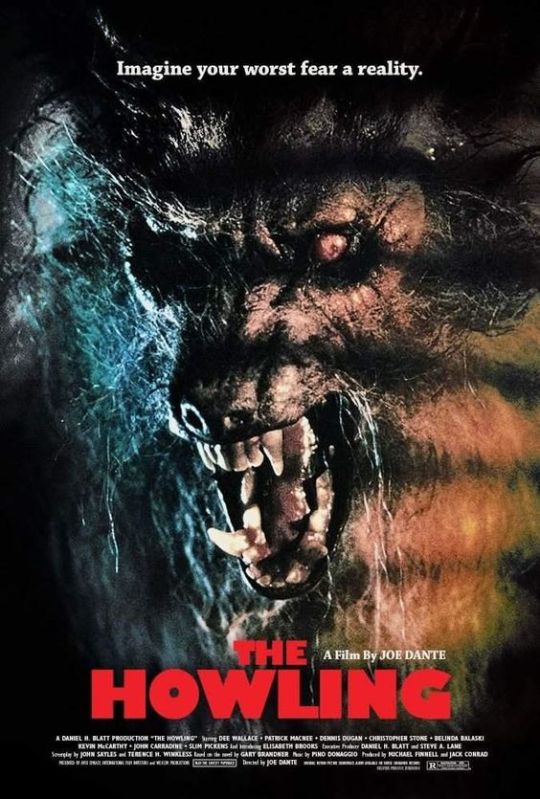
7. The Colony, from The Howling.
“The Howling” was a 1981 horror movie, based on a bestselling novel of the same name. I actually HAVE read this novel, for a change…BUT, I’ve only read it once, and it was a long time ago, so I really don’t remember a whole lot about it, sadly. As a result, I can really only judge the movie, but thankfully the movie is pretty good. The film is considered one of the key essential werewolf movies ever made, as it took the concept in a very different direction from most. In many past werewolf movies, the focus of the story was on the singular, outcast werewolf, who was usually depicted as a tragic figure: possessed by a literal inner monster they couldn’t really control. “The Howling,” however, changes things up: the story focuses on a young husband and wife, traumatized after an encounter with a sadistic serial killer called Eddie Quist. To try and recover, they head to a place called “The Colony,” a secluded countryside resort. It turns out, however, that the people who live at the Colony are all werewolves, and among their ranks is none other than Eddie and his family. There is nothing remotely tragic about most of the werewolves in the Colony: instead, the idea of the animal within is taken in a more twisted direction. This pack of wolf-people believe they are superior to the human race, and gleefully embrace their dark sides with wicked abandon; to become a werewolf, in their minds, is to embrace the carnal, primal, powerful sides of themselves. They are truly free and in control of the world around them. It’s an interesting and genuinely scary direction to go with the concept, and the film led to multiple sequels…none of which I’ve seen, and my understanding is that most of them suck, sadly. But hey, at least one of those sequels had Christopher Lee in the mix, so I guess they can’t be ALL bad.
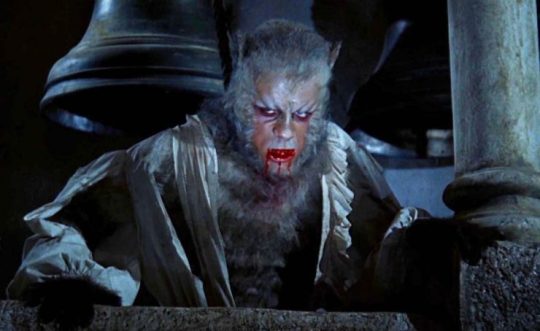
6. Leon Corledo, from Curse of the Werewolf.
When Hammer studios gained Universal as a North American distributor, they were given access to use more characters and concepts from the classic Universal Monster franchise for their films. Their one and only werewolf feature, “Curse of the Werewolf,” is usually overlooked, sadly, with many dismissing it as just being Hammer’s version of “The Wolfman.” I find this incredibly saddening because - while certain story elements are shared between the films - the two movies are extremely different, and this film takes the concept of the tragic monster in its own unique direction. Played by Oliver Reed (in his first starring role for a motion picture), our werewolf of the hour is Leon Corledo. His lycanthropy is a supernatural affliction that has infected him since birth: his mother’s tragic and extremely brutal life and death have apparently led to his blood being tainted with some evil curse, which manifests itself in the form of werewolfism. Leon gains a taste for blood at an early age, and struggles to keep his vicious, predatory side at bay. As he grows older, Leon finds that the love of a beautiful woman is able to tame his inner monster, but his struggle with his cursed nature remains a hard one. Reed’s first starring performance remains one of his best, in my opinion, mixing powerful ferocity with a gentle vulnerability. While the explanation of the werewolf’s curse is a bit bizarre, the actual trials poor Leon must endure are among the most harrowing of any movie monster.

5. Jack Howl, from Twisted Wonderland.
Well, if you know me, and you know about this game, then this really shouldn’t have been a surprise. For those who are not aware already, however, “Twisted Wonderland” is a Japanese-made mobile game themed around Disney Villains. The premise has the main character getting transported to a parallel universe, where they end up staying at a School of Dark Magic, with different houses themed around seven of those villains. Throughout the game, you encounter characters based around “The Great Seven,” as well as some other Disney characters. Jack Howl, however��he’s an anomaly. Jack isn’t really based on ANY Disney character in question. He seems to be more a tribute to just…ALL the wolves Disney has given, with references to the pack from “The Jungle Book” and the more vicious predators from “Beauty and the Beast” both being made at different points. While these may have inspired Jack, he is, in essence, a totally original character. Jack is a bona-fide werewolf, able to shapeshift from a sort of “beastman” form (pictured here) to a massive silver-white timberwolf. He is also quite possibly the most adorable werewolf in history since Eddie Munster. While he looks tough and tries to act standoffish and surly, Jack is basically just a big puppy dog. Despite his constant insistences that he doesn’t really care about anyone and isn’t out to make friends, he gets attached to people quickly, is always eager for praise from those he respects, and has a strong code of personal honor (which often gets him into trouble as much as it gets him out of it). In short, he’s a big softy who tries to seem meaner than he really is: always a fun character, in my books. It’s more my love for the game, as a whole, that lands Jack so high up in the ranks, but I’d be lying if I said I didn’t have a warm spot in my heart for this wolf-eared sweetheart.

4. Professor Lupin, from The Wizarding World of Harry Potter.
While there are a couple of werewolves in the Harry Potter universe, by far the most famous is Professor Remus J. Lupin. In the third book of the series, “The Prisoner of Azkaban,” Lupin is introduced as…well, quite frankly, the only GOOD Defense Against the Dark Arts teacher Hogwarts has ever seen. He’s supportive of his students, friendly to his peers, and ends up forming a close bond with Harry. This is partially because Remus and Harry’s father, James, were best friends in school. As a result, Lupin feels a certain responsibility towards Harry, trying his best to keep him safe. Ironically, however, it turns out that Professor Lupin is a potential danger to Harry and his friends, himself: it’s revealed that Lupin is a werewolf, and he goes from one of the main protagonists of the story to a major antagonist in the climactic chapters of the novel. Much like with Ethan Chandler and many other classic werewolves, once Lupin transforms, he changes from a good and amiable man to a bloodthirsty monster, who recognizes no friends. While Lupin has a special potion or medicine he can take to keep the wolf at bay, it is only a temporary fix. If he runs out, or just accidentally forgets to take it, you can imagine the consequences. As a result of this terrible tension, Lupin ultimately resigns from his teaching duties at Hogwarts (continuing the running gag, if you want to call it that, of Defense Against the Dark Arts always being the class with the worst luck), but he remains a major character in later books. The same goes for the movies, where Lupin was played (as pictured here) by the great David Thewlis.
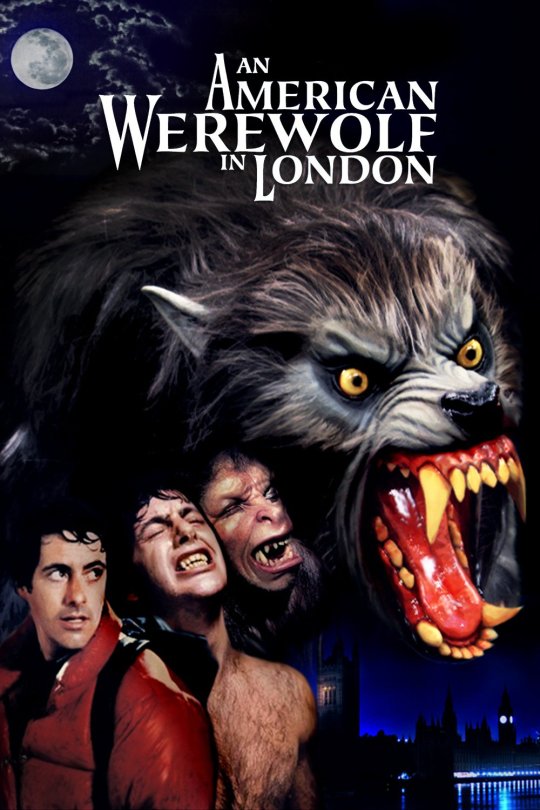
3. David Kessler, from An American Werewolf in London.
This is yet another “essential werewolf movie” in the ranks, which made a big impact on lovers of the concept back in the year of our Lord 1981 - the same year as “The Howling.” (I’m sensing a pattern.) However, while “The Howling” took the concept to its frightening extremes, by making the werewolves murderous monsters without a shred of human decency, the titular character of “An American Werewolf in London” is both one of the most tragic werewolves ever put to the screen, while also being one of the most utterly horrifying. The story begins with young David Kessler (played by David Naughton), an American graduate student, on vacation in Yorkshire. He is accompanied by his friend, Jack Goodman. While backpacking across the Moors, the two are attacked by a werewolf. Jack is savagely killed, while David is bitten and forced to become a werewolf himself. As the film goes on, David is haunted by the ghosts of Jack and his own victims, as they try to convince him to commit suicide, since only the death of the werewolf can free not only David from the curse, but also release their souls. While the film has a deliciously dark and wicked sense of humor, it is still, at its heart, a horror story, with a somber ending and a very disturbing edge. The realization of David’s werewolf form, and the transformation he undergoes, is widely regarded as one of the most horrifying in cinematic history. I am heartily inclined to agree.

2. Bigby Wolf, from The Wolf Among Us.
Let’s take a brief tangent to discuss the fairy-tale of “Little Red Riding Hood.” Many scholars and historians have suggested that the classic fable may actually be one of the earliest examples of werewolf fiction. After all, people certainly believed in werewolves at the time, and how many normal wolves can wear human clothes, speak human language, or are large enough to swallow a little girl and her granny alive? Whether this is true or not, it is not uncommon for reimaginings of the story to envision the Big Bad Wolf as a werewolf: I already discussed three such examples with the “Anime Boi Trio” at the start of the countdown. They, of course, are not the only instances: enter Sheriff Bigby Wolf, the main character of the video game “The Wolf Among Us,” based on the “Fables” comic series (which I have not read). The game is essentially a noir-styled murder mystery story, with Bigby as our resident hard-boiled detective of the hour. In typical fashion for such an archetype, he smokes, drinks, and is equal parts grumpy and sarcastically snarky. However, unlike most such examples, he’s also a werewolf: a rarity for film noir. (Unless you count Sam Spade. No way someone that cool is human.) Bigby is able to transform from a human form, to a sort of half-human form, to the “werewolf form” shown here, and finally to a giant feral wolf that’s bigger than an elephant. The story of the game once again plays with the idea of our protagonist battling his inner demons, but with a different twist: Bigby can’t change what he is, nor does he really wish to. HOWEVER, his struggle is more with his villainous past and the darkness still inside him. He’s the Big Bad Wolf, the bogeyman of many legends; that’s a hard thing to deal with when your job is to save lives and try to make amends. Being a Telltale game, the players can choose just how nasty or how nice Bigby really is, but regardless of which direction they take him, he nevertheless seems sincere in his desire to do right. It’s an interesting twist on both the fairy-tale figure and the idea of the werewolf.

1. Larry Talbot, a.k.a. The Wolfman.
Our number one pick is the entire reason WHY I set up this list the way I did. As I said before, this countdown was never about the “sexiest” werewolf, or the scariest werewolf, or anything else like that. It was simply about what character or characters came first to mind when I thought of that word. And, let’s face it…for both myself and a lot of other people, Larry Talbot - the Wolfman - is that character. The 1940 film, entitled “The Wolf Man” with a space in the middle (contemporary spellings go back and forth between that and it all being one word), pretty much established the classical lore of the werewolf that so many of us recognize today. And while it was not the first movie to tackle lycanthropy, nor to depict its protagonist as a tragic figure who was more fallen hero than true villain, it was the first to make an especially potent impact. It is because of this character and this movie that werewolves are so particularly recognized today, and the influence of this one figure cannot be overstated. Lon Chaney Jr. and his performance are an important part of why; several other people have played the Wolfman in remakes and reimaginings of the character and story (such as Benicio del Toro and Jonathan Gries), but Chaney’s performance remains the most iconic, and the one that set the bar for how so many other werewolves would be portrayed. Larry Talbot is a good and fairly normal guy who finds himself transformed into a monster against his will, and while the stories of other famous Universal Monsters got warped and went into crazy territory as the series continued, the Wolfman actually remained fairly consistent throughout his run, helped by the fact that Chaney was the only person to play the character through the entire franchise in its original years. While the films and his makeup/costume do show their age, they’re nevertheless still classics for a reason, and I doubt very many of the other characters on this countdown would even EXIST if he hadn’t set the standard. For that reason above all else, Lawrence “Larry” Talbot takes the cake as My Favorite Werewolf. Case dismissed.
HONORABLE MENTIONS INCLUDE…
Dr. Wilfred Glendon, from Werewolf of London.
Predating the Wolfman, this is one of the earliest werewolf films, and almost as iconic. While it has its merits, however, I think that actor Henry Hull’s performance in the main role is a bit stiff and stagey, which brings the character down a peg.
Cornell, from Castlevania.
Despite being a huge Castlevania fan, I’m weirdly not very familiar with Cornell, by virtue of the simple fact I haven’t looked that much into most of his appearances in the franchise. Ironic, isn’t it?
Free, from Soul Eater.
This anime/manga series is basically what you’d get if you put Tim Burton in charge of…well…an anime/manga series. Free is a recurring figure, and he’s a lot of fun, but I just tend to think of other characters first. This may partially be because it’s been a long time since I rewatched this show…I’ll have to get on that in the future. :P
There are a TON of other werewolves I could name, but after this point they kind of all conglomerate into a lupine glob of interest. Again, sorry if characters you loved didn’t show up. Who are some of YOUR favorite werewolves? Feel free to name your picks below!
#list#countdown#happy halloween#halloween#halloween special#horror#fantasy#werewolves#wolfman#wolfmen#lycanthropes#best#favorites#top 15#comics#tv#animation#movies#film#anime#manga#video games
15 notes
·
View notes
Text
Deep dives into folklore: the snow queen

The archetype of the Snow Queen, a majestic and often enigmatic figure associated with winter's icy grip, has traversed the realms of mythology and literature, captivating imaginations and embodying both the beauty and danger of the frozen landscape. This deep dive essay delves into the evolution of Snow Queens, exploring how these mythical beings have evolved from ancient folklore to enduring literary masterpieces.
I. Frozen Vestiges in Mythology:
The roots of the Snow Queen archetype can be traced back to ancient mythology, where winter deities often held both benevolent and fearsome aspects. In Norse mythology, Skadi, the goddess of winter and skiing, exemplifies this duality. With her association with snow-covered mountains and her prowess in hunting, Skadi embodies the harsh beauty of winter landscapes. Similarly, the Russian folklore character of the Frost Maiden or Snegurochka, a daughter of winter, possesses a mix of innocence and peril, symbolizing the transient nature of winter's beauty.
II. Hans Christian Andersen's Frozen Muse:
The transformation of the Snow Queen archetype reached new heights with the 19th-century Danish author Hans Christian Andersen. In his iconic fairy tale "The Snow Queen," Andersen crafted a narrative that blended folklore elements with his own imaginative twists. The Snow Queen in Andersen's tale is an alluring yet distant figure, embodying the frigid isolation of winter. Andersen's Snow Queen represents both the enchanting allure of the frozen landscape and the potential for emotional coldness and distance.
III. Frozen Hearts in Literature:
The Snow Queen archetype continued to evolve in literature, where authors explored the psychological dimensions of the frozen queen. In C.S. Lewis's "The Lion, the Witch, and the Wardrobe," the character of the White Witch draws inspiration from the Snow Queen archetype, using her icy powers to create an eternal winter. Lewis imbues the White Witch with a sense of malevolence, emphasizing the corrupting influence of an unrelenting winter on the human spirit.
IV. Disney's Frosty Royalty:
The Snow Queen archetype achieved unprecedented popularity in the 21st century with Disney's animated feature "Frozen." Inspired by Hans Christian Andersen's tale, "Frozen" reimagines the Snow Queen as Elsa, a young woman with the power to control ice and snow. The film explores themes of self-acceptance, love, and the consequences of concealing one's true nature. Elsa becomes a multifaceted character, challenging traditional notions of the Snow Queen as a purely antagonistic figure.
V. Modern Retellings and Empowerment:
Contemporary literature and media have continued to reinterpret the Snow Queen archetype, often subverting traditional narratives. Authors and creators explore the empowering aspects of winter and the complexity of female characters associated with ice and snow. Works such as Sarah J. Maas's "A Court of Thorns and Roses" series and the television series "Once Upon a Time" showcase Snow Queens as resilient and multidimensional figures, breaking free from the one-dimensional portrayals of earlier folklore.
The evolution of Snow Queens in mythology and literature reflects the ever-changing cultural landscape, encompassing themes of beauty, danger, empowerment, and self-discovery. From the ancient myths of winter deities to Hans Christian Andersen's enchanting tales and modern interpretations in literature and film, the Snow Queen archetype has proven its enduring allure. As each iteration brings new dimensions to this frozen enigma, the Snow Queen continues to cast her spell, captivating audiences with the timeless fascination of winter's icy embrace.
#writeblr#writers of tumblr#writing#bookish#booklr#fantasy books#creative writing#book blog#ya fantasy books#ya books#folklore#deep dives into folklore#deep dive
11 notes
·
View notes
Text
🤘Punk!🤘 Send in a character/s + number to reimagine them in that Punk style
(list from tv tropes 📺)
Atom Punk - A sleek, futuristic setting with "Atomic Power" logos on everything; popular in the 1950s, 1960s, or early-to-mid 1970s.
Bio Punk - A gritty, futuristic setting with heavy biotechnology-inspired elements.
Cape Punk - Realistic, deconstructive takes on the superhero genre.
Cattle Punk - The Western with steampunk elements.
Cassette Futurism - A futuristic setting built on late 20th century analog technology.
Clock Punk - Widespread use of clockwork-like technologies and machinery beyond simple clocks, often in a Renaissance/Baroque era setting.
Cyber Punk - A dark and cynical genre based on the impact of advanced computer technology on society, often as a tool for corporate or governmental oppression and resistance towards it.
Desert Punk - A sci-fi world set in a desert.
Diesel Punk - A retro-futuristic setting based on early 20th century technology.
Dungeon Punk - A dark and gritty world where spells, enchanted artifacts, and magitek take the place of modern technology.
Fantastic Noir - Film Noir mysteries with a fantasy or sci-fi twist, popularized in The '80s.
Gaslamp Fantasy - 19th century Steampunk settings with fantastical magic instead of technology.
Gothic Punk - A modern, fantasy setting which heavily draws on Gothic Horror elements.
Gunpowder Fantasy - Fantasy works based on the early modern period, roughly spanning The Renaissance through The Napoleonic Wars, i.e. the 15th to very early 19th century.
Myth Punk - Classical folklore and fairy tales rewritten with darker, postmodern elements.
Ocean Punk - Modern fantasy or speculative fiction set at sea, often drawing on elements from the age of Wooden Ships and Iron Men.
Sandal Punk - Science fiction set in the Bronze Age up until the Middle Ages, usually drawing on Ancient Greece/Rome and the Middle East (for Biblical stories).
Scavenged Punk - Culture and technology built out of scavenged junk.
Solar Punk - A futuristic setting based on renewable energy and sustainability.
Steam Punk - A retro-futuristic setting with steam power as the basis for advanced technology, generally with a late 19th century aesthetic.
Phlebotinum-Induced Steam Punk - Advanced technology run on rare or magical materials.
Stone Punk - Modern inventions and technology but made with Stone Age materials.
Tesla Punk - Lightning-based technology attributed to Nikola Tesla's alleged scientific genius.
Urban Fantasy - Fantastical elements in a modern setting.
#oc prompt#character prompt#art prompt#art meme#art challenge#clothes prompt#numbers prompt#tv tropes
13 notes
·
View notes
Text
"Percy Jackson & the Olympians" series by Rick Riordan has had a significant impact on popular culture, particularly in its portrayal of Greek mythology. Here's an in-depth analysis of the series and its influence:
### Portrayal of Greek Mythology:
1. **Modern Relevance:**
- Riordan modernizes Greek mythology, making it accessible to contemporary audiences, particularly young readers. The integration of ancient myths into a modern setting adds relevance and relatability.
2. **Relatable Characters:**
- Percy Jackson, the protagonist, and other characters are relatable teenagers dealing with typical adolescent issues. This relatability humanizes the mythical world, making it more accessible to readers.
3. **Reimagined Deities:**
- The series presents the gods and goddesses in a more approachable light, showcasing their flaws and quirks. This portrayal humanizes the deities, moving beyond traditional, distant representations found in classical mythology.
4. **Demystifying Mythical Creatures:**
- Mythical creatures like satyrs, centaurs, and monsters are depicted in a more friendly or neutral manner, challenging traditional perceptions. This approach encourages a more nuanced understanding of mythical beings.
5. **Incorporation of Real Locations:**
- Riordan integrates real-world locations with mythical elements, grounding the fantastical elements in reality. This fusion adds an immersive layer to the storytelling, allowing readers to visualize the mythic world in familiar settings.
6. **Education through Entertainment:**
- The series educates readers about Greek mythology organically. Through the characters' adventures, readers learn about myths, gods, and monsters without feeling like they are in a traditional classroom setting.
### Impact on Popular Culture:
1. **Expanding Mythological Interest:**
- "Percy Jackson" has played a pivotal role in increasing interest in Greek mythology among young readers. It serves as a gateway, sparking curiosity about classical stories and inspiring further exploration.
2. **Diversity and Inclusivity:**
- The series introduces a diverse cast of characters, reflecting a broader range of backgrounds and experiences. This inclusivity contributes to the series' widespread appeal and resonance with a diverse readership.
3. **Influence on Young Adult Literature:**
- The success of the series has influenced the landscape of young adult literature, paving the way for other authors to explore mythology and folklore in inventive ways. Riordan's approach has become a model for blending education with entertainment in literature.
4. **Adaptations and Multimedia Impact:**
- The film adaptation, though not universally praised, increased the series' visibility. Additionally, the announcement of a Disney+ adaptation presents an opportunity to reintroduce and expand the impact of Percy Jackson on a new generation.
5. **Fan Engagement and Community:**
- Percy Jackson has a dedicated fanbase that actively engages in discussions, fan fiction, and fan art. This sense of community has contributed to the enduring popularity of the series and its impact on online spaces.
In conclusion, "Percy Jackson & the Olympians" has left a lasting impact on popular culture by reimagining Greek mythology in a modern context and making it accessible to a broad audience. The series' influence extends beyond literature, shaping the way mythology is portrayed and embraced in various forms of media and cultural discourse.
#percy jackon and the olympians#percy jackson#pjo series#pjo tv show#greek mythology#modern mythology#chatgpt#ya fantasy#ya fiction
12 notes
·
View notes
Text
Structuralism and Semiotics
youtube
The music video for a-ha's "Take On Me" was released in 1985 and and utilized a groundbreaking blend of live-action and animation, specifically rotoscoping. The video's most striking feature is its unique visual style. It begins with a live-action sequence, set in a cafe where the use of lighting and cinematography sets a nostalgic and somewhat romantic tone.The most memorable aspect of the video especially during this time is its use of rotoscoping animation. This technique involves tracing over live-action footage frame by frame to create a stylized animated look. The animation transports the protagonist, into a comic book world filled with action and adventure. The video tells a narrative of a young woman, who becomes absorbed into a comic book and embarks on a thrilling adventure with the protagonist. It's the classic boy meets girl story but with a twist. The comic book setting symbolizes the power of storytelling and the ability to create one's own narrative. The video for had a significant impact on popular culture and set a new standard for music videos. Its innovative use of animation inspired countless artists and filmmakers, and it remains a beloved and frequently referenced cultural touchstone decades after its release.
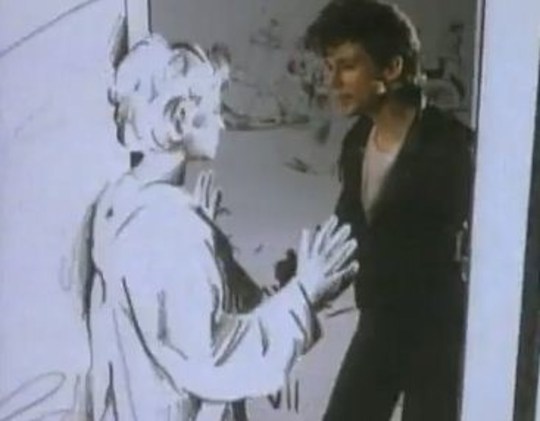
Taking a deeper analysis into the video Saussurean concepts of sign, signifier, and signified are present. In the music video, various signs are presented visually (such as characters, settings, and actions) alongside the auditory signifiers: the music and lyrics. The sketches shown throughout the video represent a signifier that conveys the concept of the protagonist imagined world or desires (signified). Analyzing this through Metz’s lens, the signifier of the animated characters entering the comic book world signifies a journey into fantasy or escapism. Escapism is a present theme in this video as it follows a narrative arc in which the protagonist transitions between the real world and the animated world representing the transition between reality and fantasy, echoing the themes of the song itself. The theme of escapism is also represented through the paradigmatic relation that is created with the contrast between the real-world setting and the animated world. Syntagmatic relations is also present in this video as the sequence of visual and auditory elements creates a syntagmatic structure.The progression of scenes, transitions, and actions forms a narrative sequence that guides the viewer through the story depicted in the video.
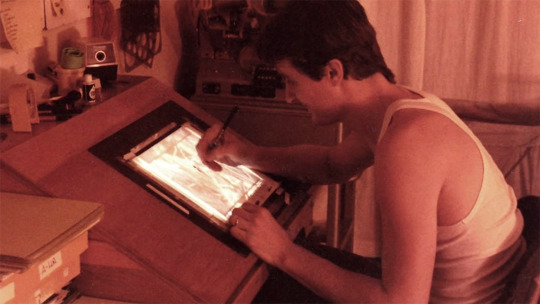
Analyzing through the lens of Roland Barthes the video might be perceived as selling the idea of transcending reality through love and imagination, much like how detergent ads sell the idea of transcending dirt to achieve cleanliness. In the video the animated world serves as a guide to a fantastical realm, inviting viewers to explore new possibilities and perspectives while guiding them through a journey of romance and adventure which can be connected to Barthes discussion on the cultural significance of travel guides. Barthes discusses the manipulation of historical narratives in films to convey certain ideologies which can be seen in the music video as it presents a narrative reminiscent of a romance or adventure film. The transformation of entering the comic book world can be seen as a modern interpretation of historical narratives, where the past is reimagined and romanticized for contemporary audiences. The romantic relationship depicted in the video can be interpreted as emblematic of idealized love or romanticized partnerships, reflecting societal norms and expectations surrounding relationships. Barthes discusses how modern myths are constructed and perpetuated through various forms of media and the music video constructs a myth around love, adventure, and escapism. The video perpetuates these myths through its visuals and narrative, reinforcing cultural ideals and values associated with romance and fantasy. In conclusion, analyzing the music video through different lenses reveals how the video constructs and perpetuates cultural myths surrounding love, adventure, and escapism. These lenses help us delve into the videos semiotic dimensions, exploring how the use of narrative, imagery, symbolism, signs and signifiers serves to create meaning within the visual and auditory text and reinforce societal norms.
youtube
The music video for "Nothing's Gonna Stop Us Now" by Starship was released in 1987 and played a significant role in the song's success. The video primarily takes place in a movie studio, reflecting the theme of the song being featured in the film “Mannequin.” This setting allows for various backdrops and sets to be utilized, adding visual interest and diversity to the video. The video follows a narrative that intertwines scenes from the movie “Mannequin” with footage of the band performing the song. The storyline of the movie, which revolves around a mannequin that comes to life, complements the message of the song about love overcoming obstacles. Throughout the video, shots of the band performing the song are interspersed with the narrative scenes. The band members are shown singing and playing their instruments with energy and enthusiasm, adding to the overall excitement of the video. The video includes romantic scenes between the characters from the movie, emphasizing the theme of love and connection. These scenes enhance the emotional impact of the song and reinforce its message of resilience and devotion. The video incorporates various visual effects, including transitions between scenes, lighting effects, and overlays, to enhance the overall aesthetic appeal. These effects contribute to the video's polished and professional look, aligning with the high production values of the song and its accompanying movie. The video features dynamic camera work and creative framing, capturing the energy of the band's performance and the emotional moments of the storyline.
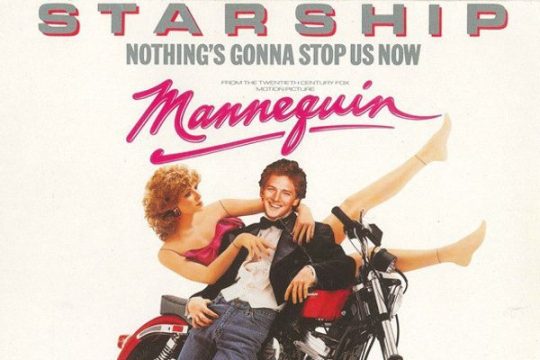
Analyzing the music video through the lens of Roland Barthes' essays from “Mythologies” offers an opportunity to deconstruct the cultural symbols and myths embedded within both the song and its visual representation. Barthes discussion of the manipulation of historical narratives to convey certain ideologies which can be seen in the video through elements such as the portrayal of the band members and use of dramatic backdrops that convey a sense of epic scale and evoke grandeur, triumph, and romance reminiscent of classical narratives. In the music video, themes of cleanliness, purity, and renewal, are symbolized through imagery such as bright, pristine settings, or the use of light and color to convey a sense of freshness and vitality. In the music video, their are references to travel and exploration, as the protagonists embark on a journey together against various scenic backdrops. These settings could serve as symbolic landscapes representing the adventure and possibilities inherent in love and partnership. The intimate moments portrayed between the protagonists represent domestic bliss and reinforce the narrative of enduring love and commitment which connects to Barthes values of stability, responsibility, and domesticity.

Metz discusses how cinema uses various codes and signs to convey meaning which is shown in the video as there are several codes such as visual imagery, music, lyrics, and performance. These codes work together to create a narrative and evoke emotions. The video follows a narrative structure that complements the song's lyrics. Based on the title and lyrics of the song it could be depicting a story of love, perseverance, or triumph over obstacles. The video utilizes cinematic techniques such as camera angles, editing, lighting, and choreography to convey its message. An example of this is the close-up shots that are used to emphasize emotions, while fast editing may create a sense of energy and excitement. Applying Metz's framework to the video allows for a deeper understanding of how its various elements work together to create meaning and evoke emotions in the viewer. In the video the facial expressions and body language of the performers, as well as the imagery used in the video to represent themes of love, determination, and overcoming obstacles. Saussure's theory of binary oppositions suggests that meaning is often constructed through the contrast between opposing concepts. Instances of binary oppositions are shown in the music video, such as contrasts in lighting, color palette, or visual motifs, which contribute to the overall message of the song. This lens gives us insights into how visual signs and symbols are used to convey meaning, emotion, and narrative in the context of popular culture and media production.

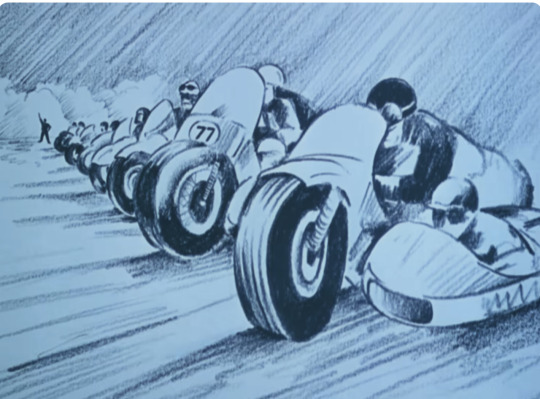
Discussion Questions:
Are there instances where the visuals seem to contradict the lyrical content?
What similarities can be drawn from both of these music videos? What about the actual songs? Is there any differences?
Do you think that the music videos represent the music correctly?
Why do you think love is portrayed the way it is in these music videos?
Do you think that semiotics were a present part when these videos were made?
Ferdinand de Saussure, Course in General Linguistics, trans. Wade Baskin (New York: McGraw-Hill Book Company, 1915)
Roland Barthes, Mythologies, trans. Annette Lavers (New York: The Noonday Press, 1972)
Metz, Christian,“Some Points in the Semiotics of Cinema. In Film Theory and Criticism, 65-77. Edited by Leo Braudy and Marshall Cohen (New York/Oxford: Oxford University Press, 2009)
10 notes
·
View notes
Text

(from other blog!)
🔥 choose violence ask game 🔥
3. screenshot or description of the worst take you've seen on tumblr
shan't be posting a screenshot, but the take that ‘defending katherine parr is defending thomas seymour’ is actually repugnant. her actions wrt elizabeth can and should be criticised — but within their proper context. katherine was a brilliant woman but she was also a woman, and legally, socially and culturally her husband overpowered her. she lived in a patriarchal society. she was negligent, at best, complicit, at worst — but she did warn ashley to keep an eye on thomas and elizabeth, did berate her husband for his ill-treatment, and did ultimately send elizabeth away. she was also pregnant with his child and the pregnancy seems to have been difficult. and elizabeth loved her; she was more her mother than anyone else. putting her on the same level as thomas seymour is just so gross to me.
8. common fandom opinion that everyone is wrong about
i PROMISE you anne boleyn does not receive the ‘worst’ historical abuse of the six wives/female historical figures. the idea of an evil, manipulative, promiscuous anne boleyn is nowhere near as culturally prevalent and pervasive as you insist it is. she very much does not have it anywhere near as bad as is claimed.
people simply do not care about anne boleyn, far more than they actively hate her — and where she does get treated with misogyny, it’s on a similar level to other female historical figures. it’s not distinct to her. moreover, what is unique to her is the level of revisionism and attention she gets. as another post has already put it: “anne's reinvention has been the most powerful and vocal in historical circles. anne is the center of almost all revisionist efforts in tudor historiography”. none of the six wives have been researched, revisited, reimagined and rehabilitated or simply discussed even a fraction as much.
we've already been over this. at this point i honestly believe insistence over this simply comes down to people looking for a thing to feel persecuted and exceptional over, while lacking the academic curiosity, talent and integrity to actually go and find something more tangible than the single most popular person in tudor history.

10. worst part of fanon
the hypocrisy/doublethink is truly something in this fandom sometimes. ‘monarchy was sacrosanct’ so therefore the commons unfailingly accepted the divine right of kings, except for all the times when they didn't and all the numerous recorded instances of royals being slandered/revolted against... but simultaneously, recognising the use of myth/prophecy and mysticism/faith in discourses of the time is ‘lionising’ historical figures, so we can't talk about henry vii and allusions to y daroganwr or king arthur but we can compare anne boleyn to classical mythology. sure!
13. worst blorboficiation
i recently saw that michael hick’s ‘the self-made king’ book about richard iii (which i haven’t read, so for all i know is very good but the title has always put me off) in a bookshop, and it reminded me how profoundly intellectually dishonest ricardians are. whether or not hicks’ book is sound, the popular/fandom approach to idealising richard iii is legitimately insane. truly i believe the only reason for mutilating the historical richard like this — to turn him into some fantasy merrie olde englande caricature of a medieval king — is to appropriate him into a racist, xenophobic, classist conservative ideal of monarchy. for as much as they might talk of him being ‘self-made’ or ‘socialist’ (as professional-at-failing-upwards matt lewis described him), they clearly do not care for such ideas, because they are centering them around (a fundamentally flawed understanding of) medieval monarchy. it's so ugly.
14. that one thing you see in fics all the time
i don’t read fanfic, but i see posts abt them and edit aus a lot and a consistent thing that i just cannot understand is the ‘fix-it’ narratives that have the women having numerous pregnancies. why? especially because the dates given essentially prove that in these aus, women never get to spend any time not pregnant or getting impregnated — including the historic protocols of lying in, churching etc., or religious conventions (sex was forbidden on certain days etc). it all basically creates an image of a husband who disrespects his wife by constantly trying to impregnate her, and a woman forced to endure the physical demands of constant pregnancy/labour with no regard for any other facet of her life/personhood. especially since these aus give these women a diabolical amount of children (including forcing twins/triplets on these women). it’s just so blatant that queenship/womanhood = being a broodmare. and, worse, these aus have the nerve to give these children horrific names.
25. common fandom complaint that you're sick of hearing
not directly what was asked but it’s genuinely exhausting how predominantly complaints about katherine howard being called a stupid slut have become wrapped up in this idea that katherine can only be worthy of sympathy if she did not willingly have sex. so often people trying to defend her, and criticising misogyny directed at her, ultimately constrain her to a fundamentally sexist idea — that sex can only be something done to her, as an unwilling participant. otherwise the implication is that comments about her intelligence or promiscuity are justified. there is no benefit to whitewashing katherine’s sexuality, and the insistence on characterising her almost exclusively as a victim is distressing. and it’s tiring having to repeatedly point this out. it simply feels like katherine howard is talked a lot but rarely as a fully actualised person in her own right.
6 notes
·
View notes
Text




shoppalestine has a variety of items but I specifically wanted to highlight their books, and a few in particular.
Light in Gaza: Writings Born of Fire
Imagining the future of Gaza beyond the cruelties of occupation and Apartheid, Light in Gaza is a powerful contribution to understanding the Palestinian experience.
Light in Gaza is a seminal, moving and wide-ranging anthology of Palestinian writers and artists. It constitutes a collective effort to organize and center Palestinian voices in the ongoing struggle. As political discourse shifts toward futurism as a means of reimagining a better way of living, beyond the violence and limitations of colonialism, Light in Gaza is an urgent and powerful intervention into an important political moment.
Blood Orange
Blood Orange is a highly emotional, important and timely poetry collection by Mx. Yaffa (They/She), a trans Muslim displaced Indigenous Palestinian. Their writings probe the yearning for home, belonging, mental health, queerness, transness, and other dimensions of marginalization while nurturing dreams of utopia against the background of ongoing displacement and genocide of indigenous Palestinians.
On Zionist Literature
Interweaving his literary criticism of works by George Eliot, Arthur Koestler, and many others with a historical materialist narrative, Kanafani identifies the political intent and ideology of Zionist literature, demonstrating how the myths used to justify the Zionist-imperialist domination of Palestine first emerged and were repeatedly propagated in popular literary works in order to generate support for Zionism and shape the Western public's understanding of it.
A Child's View From Gaza: Palestinian Children's Art and the Fight Against Censorship
A Child's View from Gaza is a collection of drawings by children from the Gaza Strip, art that was censored by the Museum of Children's Art in Oakland, California. With beautiful, high-resolution print images of the exhibit, the book also features a special foreword by celebrated author, Alice Walker, as well as an essay by MECA Executive Director, Barbara Lubin, describing the struggle against the censorship.
Note: for obvious reasons, shipping can take over a month; in addition, they are currently unable to ship to the UK, and EU customers must spend at least €180; you may have to pay additional fees to get your package through customs.
7 notes
·
View notes
Text
been working on a sort of dnd-ization of mythological races and beasts from SWANA/MENA and like where I am so far 🤔 I'm applying a sort of logic analogous to European myth where many of the physical, mortal fantasy races were originally spiritual or incorporeal before being reimagined in the popular literature as actual races/species. the "human" races I have so far (which rly just means sapient and is more of a social marker/social privilege than anything) instead of elves dwarves etc:
Deu - Persian Div, but I'm using the older/oldest terminology I can find and Classical Persian pronounces it Deu; ogres or oni in appearance, large, horned, tusked humanoids that don't get the human label due to prejudice despite very much being related
Ghouls - look like Deu but smaller (between 3.5 and 5.5 feet), and often Born without horns. Carnivorous and cannibalistic, though most settlements have extremely strict laws about it. easily distinguishable from Deu by their cloven feet.
Jinn - the "elves" of the setting; magically inclined, often reticent to admit they're related to the other races, you know how it is
Ansho - what we would know as "normal" humans; round ears, average heights, and a long history of innovation
Peri - would easily be mistaken for Jinn if not for their wings.
2 notes
·
View notes
Note
Character ask: Aphrodite
Favorite thing about them: She's a fascinating figure, full of potential for stories: a stunningly, irresistibly beautiful goddess who embodies romantic love and sexuality, who can be cruel and kind in equal measure, just like love itself. It's no wonder that she's captivated writers and artists for centuries.
Least favorite thing about them: As I said above, she can be cruel: for example, in her treatment of Psyche, and her role in starting the Trojan War. Of course this is true for most of the Greek gods and goddesses, not just her.
Three things I have in common with them:
*I'm passionate.
*I love romance (in stories, at least) and visual beauty.
*I can be hot-tempered and petty sometimes.
Three things I don't have in common with them:
*I'm not irresistibly alluring to men.
*I don't take vicious offense when people consider other women more beautiful than I am.
*Unlike her traditional depiction, I'm not blonde.
Favorite line: I'd need to read through all the various mythology sources to find one.
brOTP: Her son Eros, when she's not abusing his future wife Psyche.
OTP: Her various famous lovers (Ares, Anchises, Adonis), and in some modern retellings, her husband Hephaestus.
nOTP: Any of her own children, or anyone she's put a curse on.
Random headcanon: If there's a place where the gods and goddesses of different cultures can meet, then when she visits that place, I'm sure she enjoys lording her fame over other love-goddesses like Inanna and Freya. None of them embody love and beauty throughout Western art and popular culture the way she does.
Unpopular opinion: I'm not sure how to feel about the traditional portrayal of her marriage to Hephaestus, or about revisionist versions thereof. On the one hand, I understand the urge to deconstruct the tradition of "beautiful goddess despises her ugly husband and has affairs willy-nilly with handsomer gods and men." By pure instinct, I like seeing them reimagined as a happily married couple. But at the same time, I think of all the discourse surrounding the Hades and Persephone myth, and apply the same thoughts here. Arguably, the fact that Aphrodite is forced into a loveless marriage reflects the experience of most women in ancient Greece, and the fact that she does have affairs willy-nilly – and that she's the goddess of love but not of marriage – reflects the separation between marriage and love in ancient Greek culture. Ultimately, I'm open to both types of retelling, just like I'm open both to "happily married Persephone" and "unhappily married Persephone" in portrayals of the Underworld.
Song I associate with them: None.
Favorite picture of them:
The Aphrodite of Knidos:

The Aphrodite of Milos, or as it's better known in pop culture, the Venus de Milo:
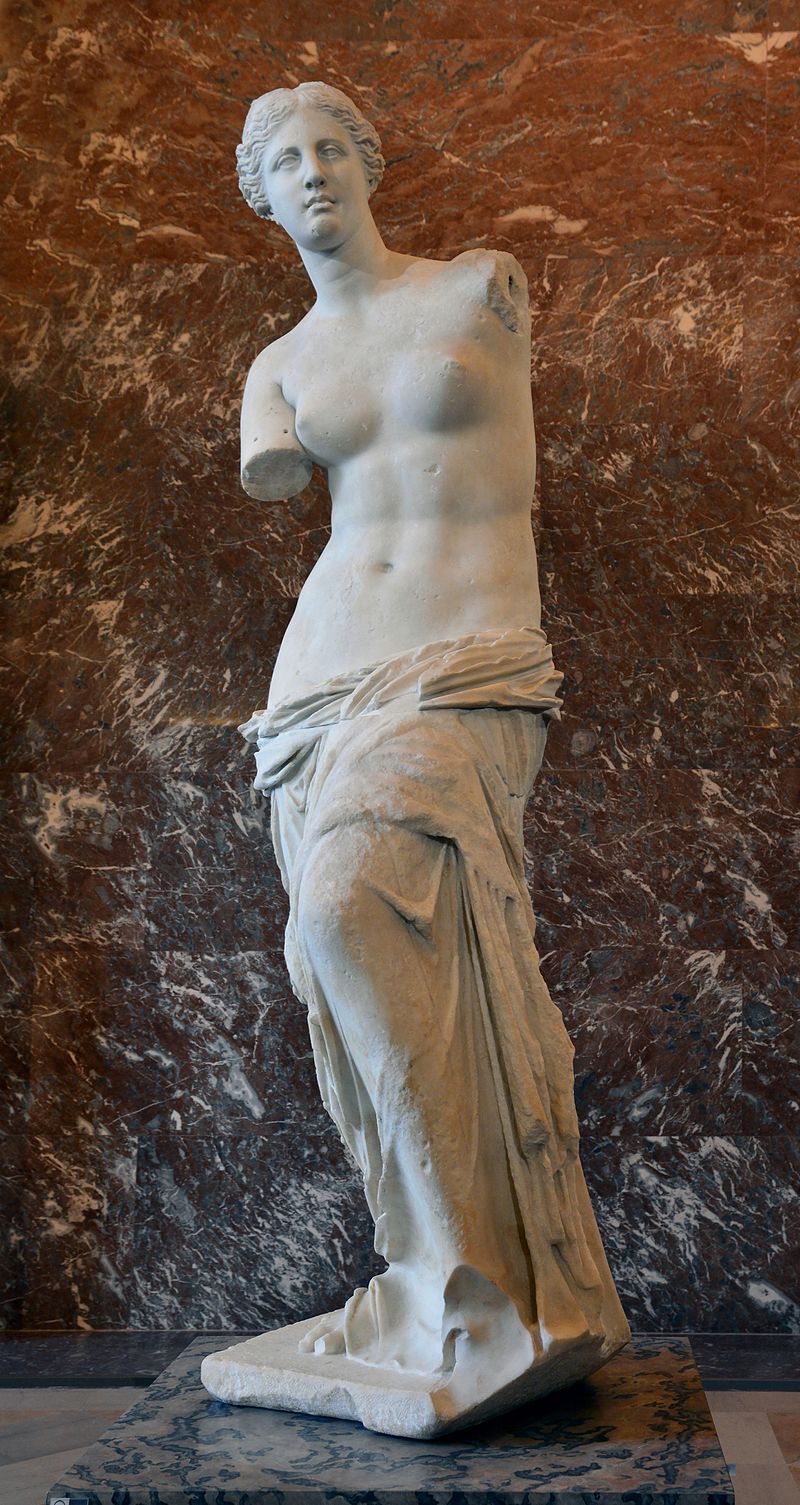
Sandro Botticelli's The Birth of Venus:
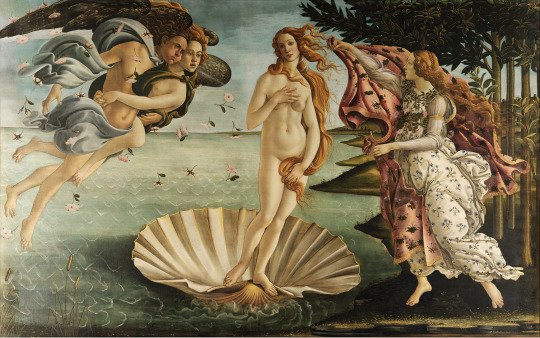
Alexandre Cabanel's The Birth of Venus:

The Sleeping Venus by Giorgione and Titian:

Titian's Venus of Urbino, assuming she really is the goddess and not just a courtesan:

Titian's Venus with a Mirror:

Jacques-Louis David's Mars Being Disarmed by Venus:
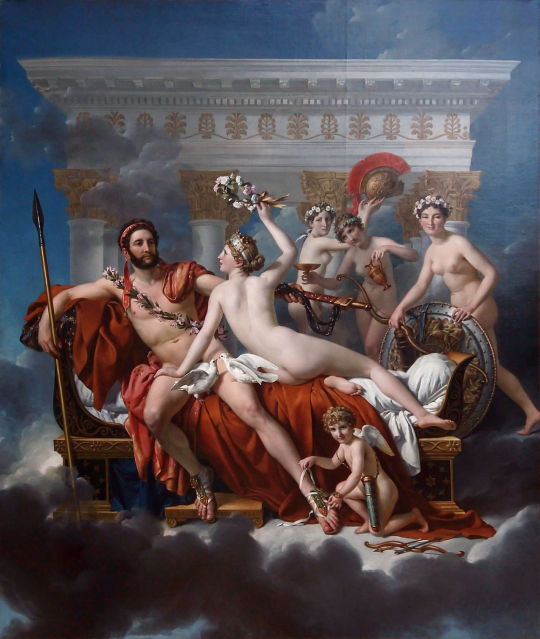
William Blake Richmond's Venus and Anchises:

This illustration of her birth from D'Aulaire's Book of Greek Myths:
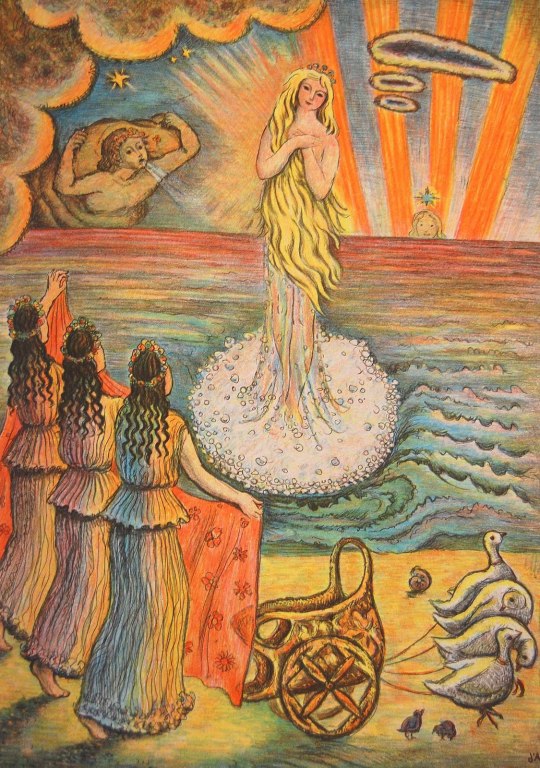
Marilee Heyer's illustration of her birth from Doris Orgel's book We Goddesses:
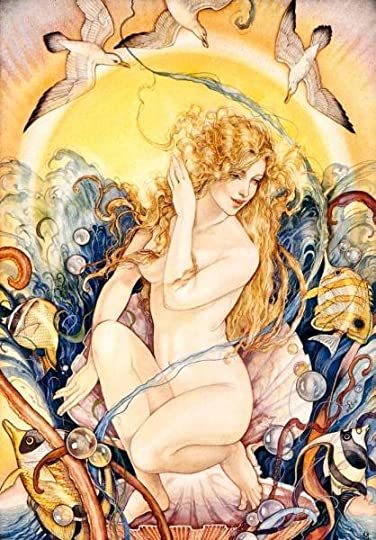
Aphrodite as she appears in Disney's Hercules – not high art, but she is cute:
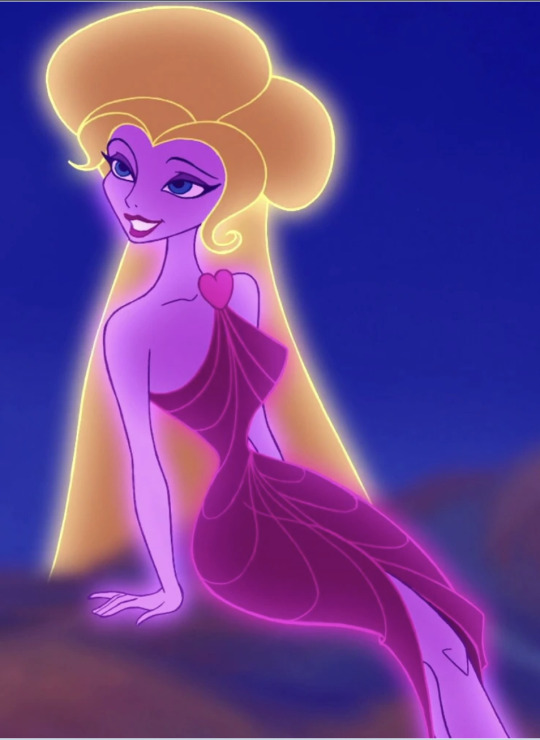
20 notes
·
View notes